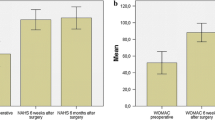Abstract
Purpose
Surgical resection of femoroacetabular Cam impingement (cam-FAI) is now a generally accepted treatment, producing adequate hip score increases. Insufficient resection at the head–neck junction is the main reason for revision. The anterolateral region of the head–neck junction is visualized only suboptimally by radiography, which can be inadequate for monitoring resection results postoperatively. Our aim was to investigate the extent of Cam resection by ultrasonography (US) and determine if there is any correlation with clinical outcome.
Methods
Altogether, 40 consecutive patients (mean age 39 years) were enrolled in this prospective study following arthroscopic Cam resection. All patients underwent standardized US examination in the ventral longitudinal section at 20° external rotation, neutral position, and 20° internal rotation the day before arthroscopy and two days afterward. Alpha angle, anterior offset, offset ratio, and anterior femoral distance were measured on sonograms. Hip Disability and Osteoarthritis Outcome Score (HOOS) and Western Ontario and McMaster University Index of Osteoarthritis (WOMAC) were conducted the day before surgery and 6 weeks postoperatively (at the earliest).
Results
Alpha angle was significantly smaller on postoperative US in all hip joint positions. At 20° internal rotation, the alpha angle decreased from 65.6 to 36.9° (p < 0.0001). All but two (5 %) patients had alpha angles <50°. Anterior offset increased significantly on US in neutral position and at 20° internal rotation. HOOS and WOMAC increased significantly. No correlation was found between measurements for Cam-FAI and the scores.
Conclusions
US may be a useful tool for monitoring Cam-FAI resection results postoperatively.




Similar content being viewed by others

References
Ganz R, Parvizi J, Beck M et al (2003) Femoroacetabular impingement: A cause for osteoarthritis of the hip. Clin Orthop Relat Res 417:112–20
Harris WH (1986) Etiology of osteoarthritis of the hip. Clin Orthop Relat Res 213:20–33
Tanzer M, Noiseux N (2004) Osseous abnormalities and early osteoarthritis: the role of hip impingement. Clin Orthop Relat Res 429:170–7
Dienst M, Kohn D (2009) Arthroscopic treatment of femoroacetabular impingement. Technique and results. Orthopade 38:429–43
Byrd JW, Jones KS (2011) Arthroscopic management of femoroacetabular impingement: minimum 2-year follow-up. Arthroscopy 27:1379–88
Byrd JW, Jones KS (2011) Arthroscopic management of femoroacetabular impingement in athletes. Am J Sports Med 39(Suppl):7S–13S
Ilizaliturri VM Jr, Orozco-Rodriguez L, Costa-Rodriguez E, Camacho-Galindo J (2008) Arthroscopic treatment of cam-type femoroacetabular impingement: Preliminary report at 2 years minimum follow-up. J Arthroplasty 23:226–234
Javed A, O'Donnell JM (2011) Arthroscopic femoral osteochondroplasty for cam femoroacetabular impingement in patients over 60 years of age. J Bone Joint Surg (Br) 93:326–31
Philippon MJ, Yen YM, Briggs KK et al (2008) Early outcomes after hip arthroscopy for femoroacetabular impingement in the athletic adolescent patient: A preliminary report. J Pediatr Orthop 28:705–10
Philippon MJ, Briggs KK, Yen YM, Kuppersmith DA (2009) Outcomes following hip arthroscopy for femoroacetabular impingement with associated chondrolabral dysfunction: Minimum two-year follow-up. J Bone Joint Surg (Br) 91:16–23
Philippon MJ, Schroder E, Souza BG, Briggs KK (2012) Hip arthroscopy for femoroacetabular impingement in patients aged 50 years or older. Arthroscopy 28:59–65
Polat G, Dikmen G, Erdil M, Asik M (2013) Arthroscopic treatment of femoroacetabular impingement: Early outcomes. Acta Orthop Traumatol Turc 47:311–7
Sadri H, Menetrey J, Kraus E, Hoffmeyer P (2006) Arthroskopische behandlung des femoroazetabulären impingements. Arthroskopie 19:67–74
Stahelin L, Stahelin T, Jolles BM, Herzog RF (2008) Arthroscopic offset restoration in femoroacetabular cam impingement: Accuracy and early clinical outcome. Arthroscopy 24:51–7
Tran P, Pritchard M, O'Donnell J (2013) Outcome of arthroscopic treatment for cam type femoroacetabular impingement in adolescents. ANZ J Surg 83:382–6
Dettori JR, Hashimoto R, Brodt E (2011) WA Health Technology Assessment: Hip surgery procedures for treatment of femoroacetabular impingement syndrome. Washington State Healthcare Authority, Olympia, WA, pp 1–165. http://www.hta.hca.wa.gov Accessed 26-08-2011
Heyworth BE, Shindle MK, Voos JE et al (2007) Radiologic and intraoperative findings in revision hip arthroscopy. Arthroscopy 23:1295–302
Philippon MJ, Schenker ML, Briggs KK et al (2007) Revision hip arthroscopy. Am J Sports Med 35:1918–21
Cavaignac E, Chiron P, Espie A et al (2012) Experimental study of an original radiographic view for diagnosis of cam-type anterior femoroacetabular impingement. Int Orthop 36:1783–8
Brunner A, Horisberger M, Herzog RF (2009) Sports and recreation activity of patients with femoroacetabular impingement before and after arthroscopic osteoplasty. Am J Sports Med 37:917–22
Papalia R, Del BA, Franceschi F et al (2012) Femoroacetabular impingement syndrome management: Arthroscopy or open surgery? Int Orthop 36:903–14
Neumann M, Cui Q, Siebenrock KA, Beck M (2009) Impingement-free hip motion: The ‘normal’ angle alpha after osteochondroplasty. Clin Orthop Relat Res 467:699–703
Lerch S, Kasperczyk A, Warnecke J et al (2013) Evaluation of Cam-type femoroacetabular impingement by ultrasound. Int Orthop 37:783–8
Horisberger M, Brunner A, Herzog RF (2010) Arthroscopic treatment of femoral acetabular impingement in patients with preoperative generalized degenerative changes. Arthroscopy 26:623–9
Nho SJ, Magennis EM, Singh CK, Kelly BT (2011) Outcomes after the arthroscopic treatment of femoroacetabular impingement in a mixed group of high-level athletes. Am J Sports Med 39(Suppl):14S–9S
Bardakos NV, Villar RN (2009) Predictors of progression of osteoarthritis in femoroacetabular impingement: A radiological study with a minimum of ten years follow-up. J Bone Joint Surg (Br) 91:162–9
Mancini D, Fontana A (2014) Five-year results of arthroscopic techniques for the treatment of acetabular chondral lesions in femoroacetabular impingement. Int Orthop 38:2057–64
Dudda M, Albers C, Mamisch TC et al (2009) Do normal radiographs exclude asphericity of the femoral head-neck junction. Clin Orthop Relat Res 467:651–9
Mamisch TC, Werlen S, Zilkens C et al (2009) Radiological diagnosis of femoroacetabular impingement. Radiologe 49:425–33
Conflict of interest
The authors declare that they have no conflict of interest.
Author information
Authors and Affiliations
Corresponding author
Rights and permissions
About this article
Cite this article
Lerch, S., Kasperczyk, A., Berndt, T. et al. Ultrasonography can quantify the extent of osteochondroplasty after treatment of Cam-type femoroacetabular impingement. International Orthopaedics (SICOT) 39, 853–858 (2015). https://doi.org/10.1007/s00264-014-2588-3
Received:
Accepted:
Published:
Issue Date:
DOI: https://doi.org/10.1007/s00264-014-2588-3



